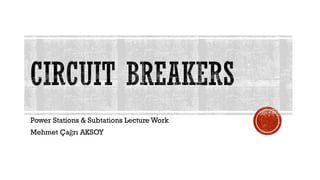Circuit breakers
- 1. Power Stations & Subtations Lecture Work Mehmet ÃaÄrÄą AKSOY
- 2. âŠA circuit breaker is a device designed to shut off an electrical circuit when too much current is flowing. âŠThis usually occurs if too many devices are plugged in or if there is a short circuit. Circuit breakers are usually installed in the electrical panel. Inside the circuit breaker, there is usually two contacts which is touched between.When detect a fault in the system, poles are divided each other. The system reacts to immediate short circuits.The process can be change different circuit breaker types.
- 3. ⊠The types of circuit breakers can be divided by these fields; âŠBy voltage level ⊠Low Voltage (1-1kv) ⊠MediumVoltage (1-72kv) ⊠HighVoltage (72.5-.. Kv) ⊠Arc suppression type ⊠Air circuit breaker ⊠CO2 circuit breaker ⊠Disconnecting circuit breaker ⊠Oil circuit breaker ⊠Sulfur hexafluoride circuit breaker ⊠Vacuum circuit breaker ⊠Magnetic circuit Breaker
- 4. âŠThe magnetic circuit breakers uses electromagnet also called solenoid. âŠWhen the current exceeds the specified value, the system is opened with the help of the electromagnet and the current is cut off.
- 5. ⊠Common in domestic, small industrial and commercial applications include Miniature circuit breaker (type B, type C and type D)and Molded Case Circuit Breaker versions. ⊠Characteristics given by international standards. ⊠Also It is made for DC applications.
- 6. âŠOil circuit breaker is very easy in construction.The oil behaves, isolator between the contacts and it uses for arc extinguishing. âŠDue to environmental and cost concerns over insulating oil spills, most new breakers use SF6 gas to quench the arc.
- 7. ⊠In this type of circuit breaker, the contacts of device surrounded by SF6 ⊠They are most often used for high voltage transmission-level voltages. Especially cold places heating might be require to prevent gas liquefaction.
- 8. 115KV SF6
- 9. ⊠The disconnecting circuit breaker (DCB) was introduced in 2000 and is a high-voltage circuit breaker modeled after the SF6-breaker.The DCB is also high voltage circuit breaker. ⊠The type of circuit breaker reduces the space requirement, increases availability and reliability.
- 10. âŠIn this circuit breaker, the fixed and moving contact is enclosed in a permanently vacuum area. âŠVacuum circuit breaker has a high insulating medium for arc extinction as compared to the other circuit breaker. âŠWhen the fault occurs in the system, the contacts of the breaker are moved apart and hence the arc is developed between them.
- 11. ⊠Works on the same principle as Sulphurre hexafluoride circuit breaker, can also be produced as a disconnecting circuit breakers, high voltage breaker ⊠Possible to reduce nearly 10 tons of carbon dioxide emissions during the productâs life time .
- 12. âŠCircuit breaker is an essential part of electrical network as it protects every device from electrical damage âŠHelps us to detect the fault and the area associated with it âŠNowadays vacuum and sulphur hexaflouride circuit breakers are widely used due to their reliable and fast operations
- 13. ⊠Wikipedia.com, Mr. Priyankar Misra's presentation, circuitglobe.com













